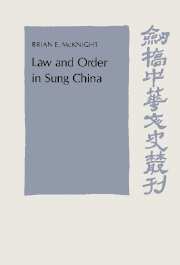Book contents
- Frontmatter
- Contents
- List of figures, maps, and tables
- Preface
- List of abbreviations
- 1 Introduction
- 2 The historical context
- 3 Crimes and criminals
- 4 Informal and semiformal agencies of law enforcement
- 5 Formal civil agencies of law enforcement
- 6 The role of the military in law enforcement
- 7 Supervision of law enforcement – the role of the intendants
- 8 Personnel selection
- 9 Urban crime and urban security
- 10 The Sung penal system
- 11 Jails and jailers in the Sung
- 12 Penal registration
- 13 The death penalty
- 14 Modifications of penalties
- 15 Conclusion
- Glossary
- Bibliography
- Index
7 - Supervision of law enforcement – the role of the intendants
Published online by Cambridge University Press: 23 December 2009
- Frontmatter
- Contents
- List of figures, maps, and tables
- Preface
- List of abbreviations
- 1 Introduction
- 2 The historical context
- 3 Crimes and criminals
- 4 Informal and semiformal agencies of law enforcement
- 5 Formal civil agencies of law enforcement
- 6 The role of the military in law enforcement
- 7 Supervision of law enforcement – the role of the intendants
- 8 Personnel selection
- 9 Urban crime and urban security
- 10 The Sung penal system
- 11 Jails and jailers in the Sung
- 12 Penal registration
- 13 The death penalty
- 14 Modifications of penalties
- 15 Conclusion
- Glossary
- Bibliography
- Index
Summary
General problem of control
Governance is a control problem. We generally think of law enforcement as controlling those who are outside the ruling group, but actually control has two faces: control of outsiders and of insiders. Dual control exists in all parts of the political apparatus; nowhere is it more important than in those segments of the government that have access to armed force. Law-enforcement and military systems present the ruling group with a serious dilemma. It is necessary to develop effective users of force, to counteract those who want to do violence to the existing order, but this need must be balanced against the necessity of keeping the users of legitimate force from becoming too powerful.
The Sung were unsurpassed among the major Chinese dynasties in dealing with this problem. Their success in creating a sufficient but not excessive system of the institutions of force is reflected both internally and externally. It is often said that the Sung were militarily weak. Certainly this was true in the sense that the Sung never succeeded in retaking the area inside the Great Wall held by the Liao dynasty. Then, in the 1120s the Northern Sung was disastrously defeated by the newly powerful Chin state and survived only as the truncated Southern Sung state. Finally, in the late thirteenth century the Sung were overthrown by the Mongol founders of the Yüan dynasty. However, strength and weakness are measures not just of the internal power of a state but also of the power of its enemies.
- Type
- Chapter
- Information
- Law and Order in Sung China , pp. 228 - 250Publisher: Cambridge University PressPrint publication year: 1992

